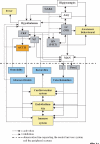Science review: The brain in sepsis--culprit and victim
- PMID: 15693982
- PMCID: PMC1065096
- DOI: 10.1186/cc2951
Science review: The brain in sepsis--culprit and victim
Abstract
On one side, brain dysfunction is a poorly explored complication of sepsis. On the other side, brain dysfunction may actively contribute to the pathogenesis of sepsis. The current review aimed at summarizing the current knowledge about the reciprocal interaction between the immune and central nervous systems during sepsis. The immune-brain cross talk takes part in circumventricular organs that, being free from blood-brain-barrier, interface between brain and bloodstream, in autonomic nuclei including the vagus nerve, and finally through the damaged endothelium. Recent observations have confirmed that sepsis is associated with excessive brain inflammation and neuronal apoptosis which clinical relevance remains to be explored. In parallel, damage within autonomic nervous and neuroendocrine systems may contribute to sepsis induced organ dysfunction.
Figures

References
-
- Sharshar T, Gray F, Lorin de la Grandmaison G, Hopkinson NS, Ross E, Dorandeu A, Orlikowski D, Raphael J-C, Gajdos P, Annane D. Apoptosis of neurons in cardiovascular autonomic centres triggered by inducible nitric oxide synthase after death from septic shock. Lancet. 2003;362:1799–1805. doi: 10.1016/S0140-6736(03)14899-4. - DOI - PubMed

